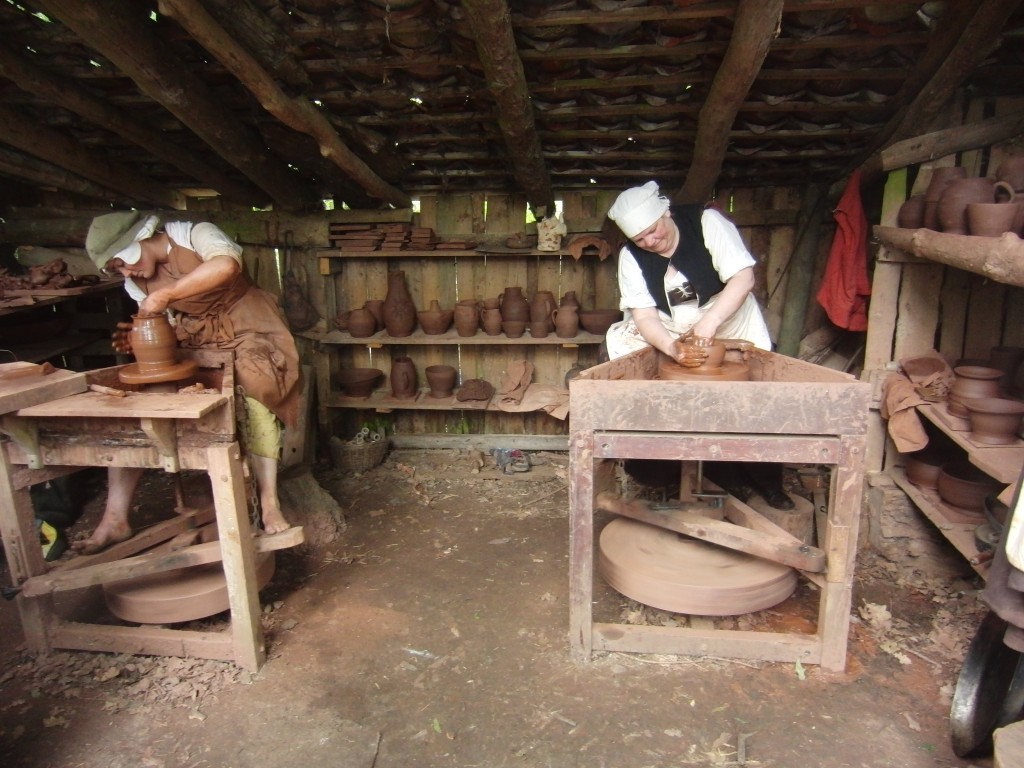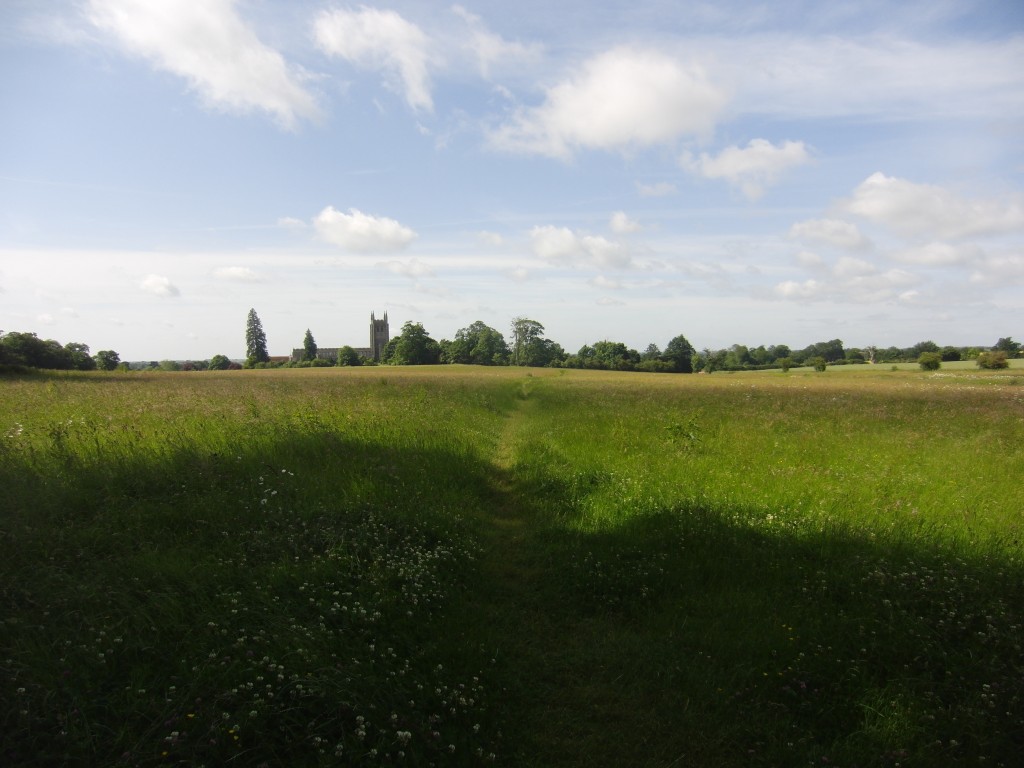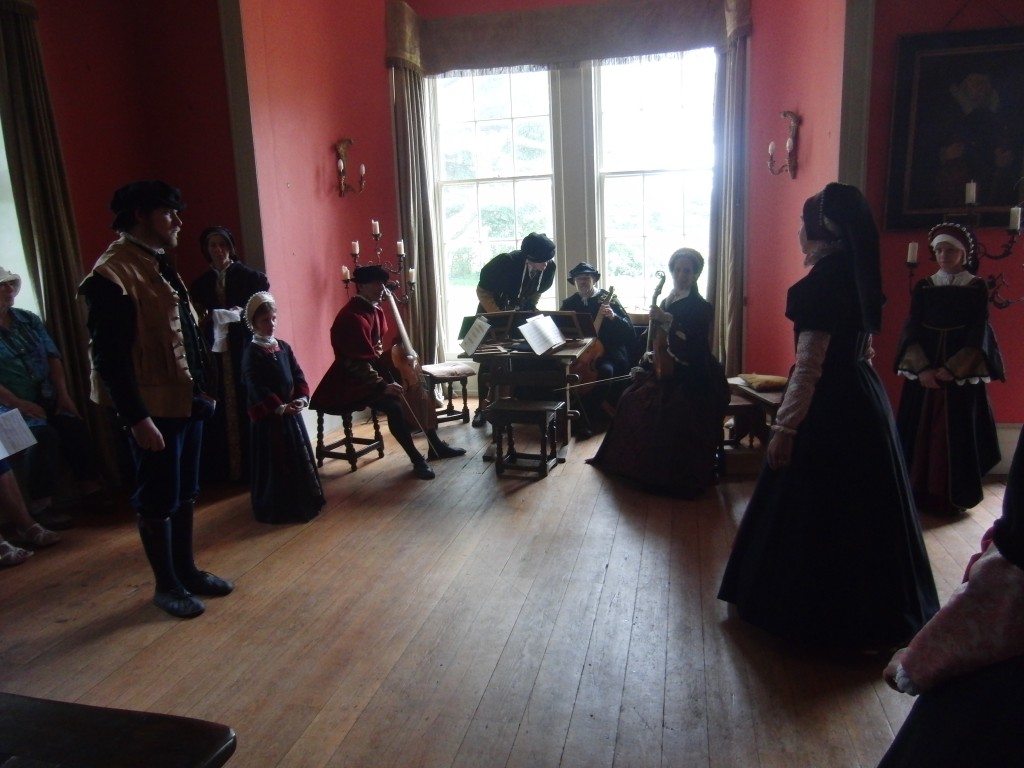Kentwell Hall
Saturday, June 23rd
So, we had grand plans for today, that are probably not what anyone else in their right mind would have done. There is, out in a town called Long Melford, a Tudor Hall called Kentwell. And while the Hall is often open to tourists, on certain dates, they also do re-enactments of different time periods, ranging from Tudor all the way through WWII. Saturday was a Tudor day! Now, we’d heard about Kentwell because a lot of information about the daily life, artifacts and costume of average Tudors has been coming from people involved with Kentwell in the last few years. We have a book, for example, on Tudor costume, from a woman at Kentwell. So we had very high expectations for the awesomeness of this re-enactment.
Getting to Kentwell was an adventure in itself! We took a train from London, which passed right by the Olympic Park (the torch looks cool!) out into the countryside. We switched trains at a town called Marks Tey, and the train we switched onto was 1 car long! It also sounded like a slightly sick lawnmower. It was a lovely ride, though, especially because for most of it, we had the train basically to ourselves. Hint to people traveling in the UK – book things online ahead of time! It almost always results in a discounted rate and no waiting in freakishly long line. Also, if anyone was thinking of going to the Olympics – it is going to be CHAOS. It was chaos-y with not all of the Olympics going on, and I do not see how they are going to make it less so in a month. Just saying.
When we finally got to Kentwell, we realized we were early, so we went for a wander in Long Melford. We found an awesome path through the fields of flowers – they have these awesome step things for getting over fences that apparently, sheep can’t do – and a beautiful little church. We also managed to find a used book sale, and an antiques rummage sale, both of which were fun to pick through. Then we headed back up to Kentwell.

This was just one of many of these that we found – a step to get over the fence. So clever! And walking through the fields is lovely.
The first thing about Kentwell is that they encourage you to change your money from modern money into pennies, tuppence and groats (four pennies). You don’t have to, but it did make it kind of fun to see things on sale for a penny. When you first go through, you can see the brick manor house at the end of a long driveway, surrounded by lawns and a moat. One thing that was pretty cool was that it wasn’t all packed into one place. All of the people and things to see were very spread out, and you had to really wander around to see everything. We started off in the forest, and saw people working the local clay on wheels to make pots and bowls and things, near where they were stoking up the fire for the kilns. You definitely get the sense that everything that was being done was for a purpose – they actually used the stuff they made and did. They had a farm yard, which contained stabled horses, and a wagon, as well as a young woman doing straw plaiting, and an old woman telling stories. There was an encampment of a noble family and their retinue, including the younger sister of Lady Jane Grey. They were there, of course, for the wedding happening tomorrow.

Woodcutters. Gotta say, the guy on the left was having some serious difficulty. I totally could have done it better. Hehehe

Making clay pots! The girl on the left was very funny. She had made her pot slightly too thin, and it was getting all wobbly. “When in doubt, put a spout!”

An encampment of nobles near the manor. Their dresses were pretty, and the little girl was adorable.
There were people playing with swords, which of course stopped Kevin cold for a good half hour, as he discovered that one of them was willing to talk about sharp pointy things with him. There were also these gigantic, furry donkeys in a pen; I think they were Spanish, but they looked weird. We found some of the arts and crafts as well – there were women working on making felt hats, and others who were dyeing fabric, as well as a large complement of spinners, weavers, carders and so on in the upstairs. They do keep a flock of sheep, and since it’s just after shearing, the loft was full to the rafters. Mind you, this is all before we’d even set foot in the main house, and we hadn’t even gone around to the other side.

Natural dyeing! They had a couple of pots going with different things, and a rainbow of yarn hung up.

Felting hats! As a side note – I tried this when we got home. Mine came out like some sort of sea creature. Will have to try again, I suppose.

A school for the children! They were working on their sums and letters, and a table off to the side was for playing games.
In the main house itself, one of the central features is the daily dinner (lunch), which is prepared in the huge kitchens, and then presented and eaten by the nobles in the dining room. They have a large company of men and boys who are the footmen to the table, setting it, and waiting it (as women were cheaper labor, it was a sign of wealth if you could have men to wait your tables). There was an adjoining parlor where musicians were playing and someone was teaching a company of young ladies the latest dances.

The manor hall itself, with the moat and all. The moat didn’t go all the way around… Don’t really know why… Maybe just is extra fancy fish pond.
Attached to the main house were the brewhouse, where they were working on a batch of ale. No one drank water, ever, so beer and ale were very important because they were safe to drink – the brewing process killed all the bacteria and so on. Not that they knew that, but it worked, so they did it. There was also the bake house, with the huge oven in which all of the bread for everyone on the manor would have been baked, and the dairy for milk, butter and cheeses. Upstairs was rooms dedicated to herbs, and where people were working on needlework. Behind the manor, there was an enormous garden. Now, it was pretty clear that the garden had been re- done in a sort of Victorian walled garden, but they had taken the different beds, and grown herbs and things of the Tudor period. They were also very beautiful, and there was a peacock strutting around showing off for no one in particular.

Madder plants! The roots of these plants are used for red dye. Kevin and I are thinking of letting them take over part of the garden, just for fun.
Around the other side, and the front, there was an alchemists’ hut, and a stall selling fruit and fresh baked biscuits (cookies). There were a several men recently returned from trade, with a greatly improved navigational map of the world, and a man in charge of creating and regulating coats of arms. At around 3, because it was Midsummer, they had a big parade and bonfire, and afterwards there was dancing for everyone. They had a couple of very fun very easy dances, as well as a significantly simplified version of Peascods. All in all, it was a very good day, and when they kicked us out, we were surprised how fast time had gone.






















